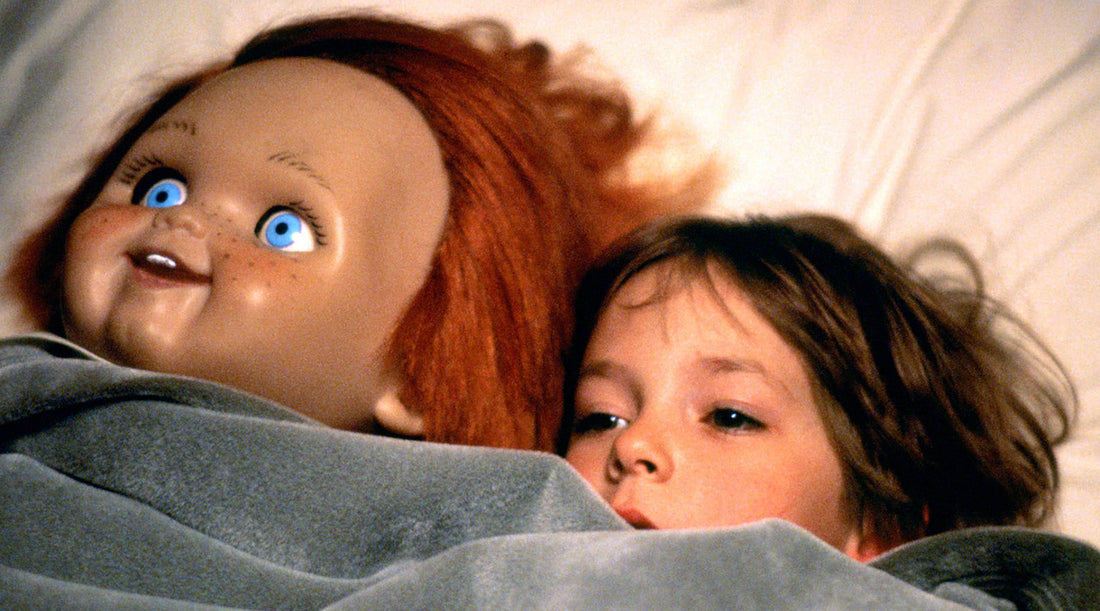Shout! employees have written in to vouch for each film in the Child's Play franchise, which has been scaring and delighting audiences for over 30 years. Whether you prefer the O.G. or one of the wackier sequels, there is a Chucky for every occasion.
Child’s Play – Joey G.
Does it get scarier, funnier, or more iconic than the original Child’s Play?
To say it was a game-changer would be an understatement – Child’s Play yanked the killer doll genre violently into the 20th century.
Up to that point, the subgenre mostly consisted of creepy ventriloquist dummies being puppeteered by murderous humans (so, not even killer doll movies, really), or fleeting bursts constrained to the anthology format. Hard to believe, but prior to Child’s Play, you’d be hard pressed to find an actual full-length killer doll movie.*
With Child’s Play, gone was the clunky stop-motion animation that inhabited prior films from the genre. Here, Chucky was animatronic – his movements handled via remote control by Brock Winkless (Tales from the Crypt, Terminator 2) and Kevin Yagher (Friday the 13th: The Final Chapter, A Nightmare on Elm Street 4), who also designed Chucky’s iconic look. That, combined with actors in Chucky costumes and forced perspective sets, made Chucky suddenly very real; his movements fluid and life-like, the audience unable to tell how the magic was happening.
And how can we forget Chucky’s expletive-laden vocabulary? Other killer doll flicks, like Puppet Master and Trilogy of Terror, featured toys that grunted or growled, but nothing like the verbose vulgarity that spewed forth from Chucky’s tiny mouth in a frothy rage. It would be kind of funny if it weren’t so terrifying.
Perhaps what set Child’s Play most apart from its predecessors – and what made it so unsettling – was making its lead victim a six-year-old boy. Not since The Exorcist had a movie shown a child being so relentlessly terrorized for its entire runtime. Amid the Stranger Danger and Satanic Panic that imbued the subconscious of the 1980s, a murderous doll (inhabited by the soul of a serial killer) attempting to abduct and possess the body of a small child didn’t play as campy – it was more like something you would’ve heard about on the nightly news.
(*We didn’t forget you, Dolls [1987].)
Child’s Play 2 – Michael K.
The film’s opening makes a meal out of answering the obvious question: how is Chucky back, anyway? The answer is a combination of corporate negligence and greed. In a sequence that would not be out-of-place in a Paul Verhoeven movie, we watch as the surviving pieces of Chucky are slowly scraped clean of gore and reassembled, culminating in a fatal industrial accident. The corporate executive who witnesses all this is only concerned that there’s a swift coverup—if word gets out, it could affect toy sales!
Alex Vincent reprises his role as Andy Barclay (now 8 years old) in Child's Play 2 and is even better than in the first film, capturing the character’s mix of innocence and trauma. Neither of the previous film’s stars (Catherine Hicks and Chris Sarandon) reprise their roles, but the movie takes advantage of their absence by putting Andy in foster care and at a new school. These environments are perfect for dramatizing the ongoing theme of the series: adults not listening to children—at their own peril.
And there’s plenty of peril to be found. Andy’s foster parents are both killed by Chucky (his foster father trips and breaks his neck; his foster mother dies off screen, but it was something nasty involving a sewing machine). Chucky also stabs Andy’s social worker to death and beats his teacher (played perfectly by Beth Grant, anticipating her role in Donnie Darko) to death with a yardstick.
Stefan Czapsky’s expressive cinematography fills the frame with both shadows and bright colors—anticipating his work on both Batman Returns (1992) and Matilda (1996). It’s a departure from the more realistic look of the first film, but it's a perfect fit for the sequel.
The film’s high point is its climax at the Good Guy Doll factory, where Andy and his foster sister, Kyle, are chased by Chucky before turning the tables on the killer doll, covering him in molten plastic and finally finishing him off (for this film at least) by inflating his body with a high-pressure air hose until he explodes.
Child’s Play 3 – Joey G.
The third entry of a horror franchise is usually when things get interesting – for better or worse. Sometimes, it’s magic (Jason got his hockey mask; Freddy became a quippy icon), and sometimes it’s a headscratcher (Michael Myers peaced out; the less said about Jaws 3-D, the better).
Like its franchise brethren, Child’s Play 3 offers up something unexpected on the third go-round: A location change. Instead of the icy dangers of Chicago (Child’s Play) or the deceptively threatening suburbs (Child’s Play 2), for this entry we find ourselves … at a military school. That’s right: the traumatized Andy Barclay, at this point a 16-year-old misfit whom no foster home can hold, is shipped away to military school.
Naturally, Chucky is resurrected and tracks down Andy to the school. But Chucky’s attention soon turns to one of Andy’s fellow cadets, 8-year-old Ronald Tyler – a new victim who Chucky can easily coax into possessing.
Perhaps the most interesting part of Child’s Play 3 is that its cast is finally comprised of your typical slasher victims – teenagers. Child’s Play and Child’s Play 2 had the distinct honor of featuring primarily adult characters being pursued and put down by the killer doll.
Regardless of whether you love or hate the change of scenery that Child’s Play 3 decided to try out, there is no denying the final set piece at the amusement park is an all-timer. Hyper-colorful lighting, smoke, strobe effects, and a giant Grim Reaper swinging a menacing scythe like a literal Sword of Damocles. A fitting hellscape for Andy and Ronald’s final showdown with that lil’ devil, Chucky.
Bride Of Chucky – Emily H.
Is there a more beautiful love story than Chucky and Tiffany? In Bride Of Chucky, Chucky’s old flame from when he was a human serial killer, Tiffany Valentine (Jennifer Tilly), gathers what’s left over of his doll form after Child’s Play 3 and brings him back to the land of the living, though still in small plastic form. Jennifer Tilly has brought life to the series in more ways than one since her introduction, making us believe in love between a woman and a doll as she walks the line of sincerity and absurdity.
It’s Tiffany’s own belief in love that sets her apart from Chucky. it would have been easy for Tiffany to have similar motivations and a sense of humor to Chucky, but while she enjoys the chaos, she also want something more. She wants connection. And when they kidnap a pair of young adults to take over their bodies, it’s Tiffany who decides that she and Chucky deserve their fate. A young Katherine Heigl (pre-Grey's Anatomy and her own bridal movie, 27 Dresses) and Nick Stabile (Sunset Beach) are the young couple looking to elope who Jennifer Tilly asks for the small favor of transporting strange dolls across state lines. FYI: if someone asks you to do that, don’t! The human couple’s wide-eyed naivete and excitement for the life before them provides stark contrast to the cynicism of their pint-sized passengers. Roles from John Ritter, Kathy Najimy, and Alexis Arquette round out the cast and make the film a fun time capsule of the late ‘90s.
Bride of Chucky features the most iconic outfit of the series outside of the Good Guy overalls when Tiffany dons her bridal gown and leather jacket. She also gets a phenomenal makeover scene set to “Call Me" by Blondie. “Barbie, eat your heart out,” indeed.
Seed Of Chucky – AJ M.
It’s basically a cardinal rule that at some point, every great horror franchise must dip a toe into the well of absurdity. Swimming in a sea of nutty slasher movies, Seed Of Chucky jumps the shark with outrageous extremity and pushes the Child’s Play franchise into deranged comic territory. Yet in spite of its over-the-top violence and crude humor, it has aged surprisingly well as an object of cult fascination.
Radical self-awareness separates Seed from its four predecessors; the irreverence makes Bride Of Chucky feel like Sophie’s Choice in comparison. Creator Don Mancini stretches the limits of horror-comedy with his meta Hollywood setting (despite filming in Romania), a bevy of outlandish kill sequences, and the introduction of Glen, child spawn of Chucky and Tiffany who quietly harbors a gender identity crisis.
Seed’s cast is a beloved snapshot of the early 2000s when hip-hop was ingrained in every facet of pop culture, from MTV to the big screen. Drawing from the same legacy as Snoop Dogg in Bones or Busta Rhymes in Halloween: Resurrection, Redman shores up the supporting cast of Seed Of Chucky as an exaggeration of himself. The New Jersey rapper parlays his talents as a rap lyricist to a true-blue film director whose latest project is a biblical epic about the Virgin Mary.
Vying for the coveted role is Jennifer Tilly as a caricature of herself, who doubles as the voice of Tiffany Valentine. Even John Waters makes an unexpected appearance as a sleazy paparazzo. And of course Brad Dourif returns as the pint-sized killer, who alongside his lover and newfound kin will slash their way to infamy in this undervalued sequel that’s bloody, unsophisticated fun.
Curse Of Chucky – Emily H.
Six films deep in a horror franchise, it would be reasonable to assume there is nothing new to be done with the tiny terror that is Chucky. Luckily for the viewers, the series feels reborn because of the film’s formidable secret weapon: Fiona Dourif.
Curse Of Chucky was released 9 years after Seed Of Chucky and it recaptures the horror of the earlier films while continuing to evolve, this time by leaning just as strongly into psychological terror as into gore and dramatic kills. Fiona plays Nica, a young woman who suspects that the talking, red-haired doll her visiting niece has been playing with may be behind the mysterious death of her own mother. Chucky takes a perverse pleasure in torturing Nica, who is a wheelchair user and isolated without her parents. Nica’s mounting rage at the doll paves the way for the next film as well as the Chucky television series on Syfy. Though Curse Of Chucky isn’t a horror-comedy in the same way Seed Of Chucky is, there is a playfulness to Fiona’s performance that makes her ideal for this universe.
As the daughter of Brad Dourif, the voice of Chucky since Child’s Play, Fiona has been surrounded by the franchise since childhood. These family ties serve as a thrilling undercurrent to Nica’s face-off against the doll, which is the best rivalry of the series. Nica has everything taken from her by the whims of a toy and she fights back tooth and nail. There is a true, inescapable terror in the loneliness that Nica faces and in not being believed which culminates in her being sent to a mental health facility. Fiona carves her own path in the world of Chucky, with a committed performance that is wholly unique.
Cult Of Chucky – Emily H.
The final film in the original franchise was well received by critics and featured more of the original movie’s Andy Barclay (Alex Vincent), now an adult who is ready for revenge. Plus, any appearance from Jennifer Tilly is a welcome one, and she re-joins the fun as Tiffany Valentine with a meta twist of the doll having taken over actress Jennifer Tilly’s body. Cult Of Chucky follows Nica (Fiona Dourif) to the asylum, which creates a situation ripe for carnage and mayhem as Chucky preys upon a vulnerable populace. Nica has been convinced that she was responsible for some of Chucky's murders but is awakened to the truth when Tiffany drops off a Chucky doll during a visit.
Chucky has a few new tricks up his sleeve and possesses the residents of the institution, leading to unforgettable scenes of Fiona, now inhabited by the soul of Chucky, becoming Charles Lee Ray with aplomb. Her physical commitment to the role in all its forms is memorable and terrifying.
Andy gets to turn the tables on his one-time tormentor and keeps the scarred head of a prior Chucky doll in his home to torture at his leisure. We see how Chucky has affected the lives of everyone he has touched over the years and it's no surprise that the next step in his circle of influence is to start his own cult.
As Jennifer Tilly says in the movie, “A true classic never goes out of style.” The series continues to weave together the classic elements of the first Child’s Play with new characters that feel so perfectly at home in this world, which has allowed this franchise to successfully span more than 3 decades in its various forms. Chucky will always find more victims, and we’ll be along for the ride.
















